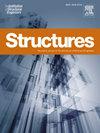纳米sio2改性再生骨料混凝土的多参数分析:疲劳损伤及细观机理
IF 4.3
2区 工程技术
Q1 ENGINEERING, CIVIL
引用次数: 0
摘要
采用纳米sio2 (NS)浸泡再生粗骨料(RCA)的方法提高再生骨料混凝土(RAC)的疲劳性能和微观结构性能。以RCA替代比、NS浓度和应力水平(Smax)为变化参数,设计了108个试件进行压缩疲劳和细观机理分析。测量了纳米sio2改性再生骨料混凝土(NSMRAC)的残余应变曲线,提出了其压缩疲劳损伤演化模型。采用扫描电镜(SEM)和低场核磁共振(LF NMR)对试样的微观结构进行了分析。结果表明:在相同置换比和应力水平下,2 % NS浸泡浓度的NSMRAC试件损伤值最低,模型预测与试验数据吻合较好;SEM和LF NMR测试表明,NS颗粒的加入有效改善了RCA的微观结构。该研究为NSMRAC的疲劳设计提供了科学依据,促进了NSMRAC在工程中的应用。本文章由计算机程序翻译,如有差异,请以英文原文为准。
Multi-parameter analysis of nano-SiO₂ modified recycled aggregate concrete: Fatigue damage and microscopic mechanisms
This study employed the method of nano-SiO2 (NS) soaking recycled coarse aggregate (RCA) to enhance the fatigue performance and microstructure performance of recycled aggregate concrete (RAC). With RCA replacement ratio, NS concentration, and stress level (Smax) as the varying parameters, 108 specimens were designed for compression fatigue and micro-mechanism analysis. The residual strain curves of nano-SiO2 modified recycled aggregate concrete (NSMRAC) were measured, and the damage evolution model of compressive fatigue was proposed. The microstructure of the specimen was analyzed by scanning electron microscopy (SEM) and low-field nuclear magnetic resonance (LF NMR) test. Results showed that the NSMRAC specimen with a 2 % NS soaking concentration exhibited the lowest damage value under identical replacement ratio and stress level, with model predictions in close agreement with test data. The SEM and LF NMR tests showed that the addition of NS particles effectively improved the microstructure of RCA. This study provided the scientific basis for fatigue design of NSMRAC, promoting the application of NSMRAC in engineering.
求助全文
通过发布文献求助,成功后即可免费获取论文全文。
去求助
来源期刊

Structures
Engineering-Architecture
CiteScore
5.70
自引率
17.10%
发文量
1187
期刊介绍:
Structures aims to publish internationally-leading research across the full breadth of structural engineering. Papers for Structures are particularly welcome in which high-quality research will benefit from wide readership of academics and practitioners such that not only high citation rates but also tangible industrial-related pathways to impact are achieved.
 求助内容:
求助内容: 应助结果提醒方式:
应助结果提醒方式:


